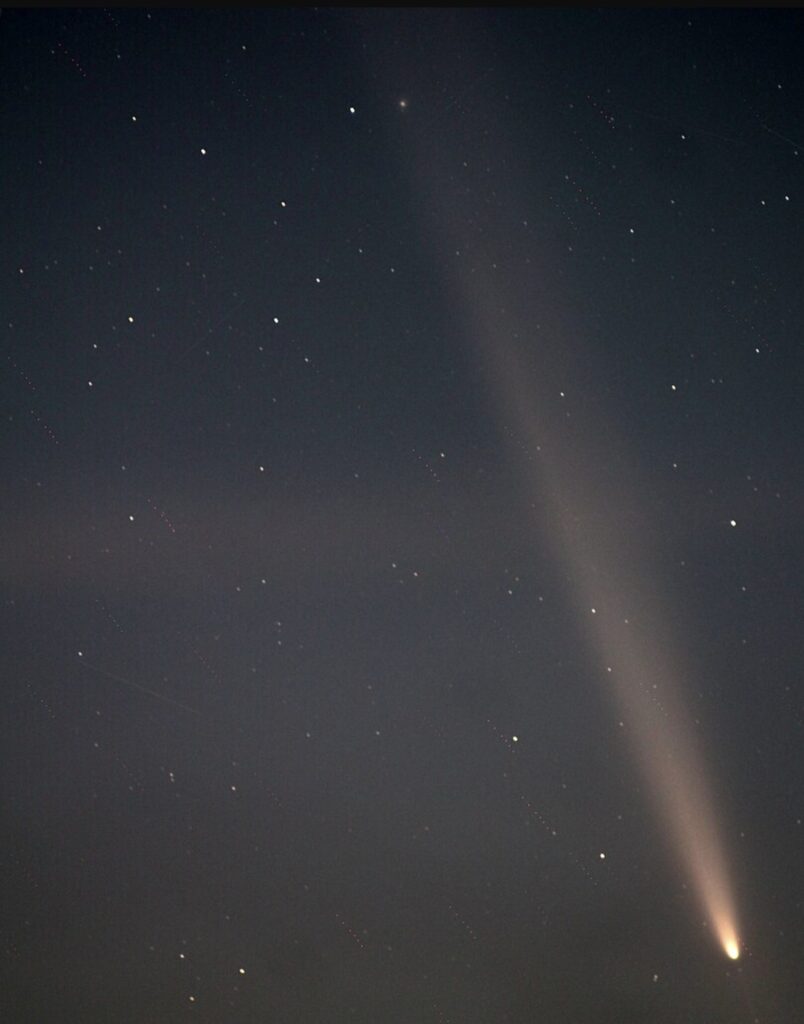Almanac: Celestial Visitor

Some hopeful comet hunters gathered at sunset on Wednesday under the big sugar maple on Mt. Pollux in South Amherst. Photo: Stephen Braun
The comet was not cooperating. At all.
I had walked up Mt. Pollux this past Wednesday (10/9) about a half hour after sunset in the hopes of spotting comet Tsuchinshan-ATLAS. Venus blazed low on the horizon. A full “super moon” rose in the east, as big and bright as it ever gets—about 14% brighter than normal because it’s so relatively close to the earth in its orbit. The sky was cloudless. But nobody could see anything remotely resembling the kinds of photos circulating on the internet in the past few weeks. What the heck?
In ancient times, people were well aware of the regular movements of the heavenly bodies and thought that the positions and motions of the sun, moon, and planets influenced affairs on the earth. It was troubling, therefore, when unexpected things happened in the sky. Such events were generally interpreted as omens of famine, drought, or some other catastrophe.
One of the things that most often caused a stir among the ancients was the appearance of objects that looked fuzzy or which trailed what looked like smoky tails. Such objects reminded people of a woman running, her long hair streaming out behind her. The Greek word for “long haired” is “kometes” and that’s what they called the objects. The Romans modified that idea slightly, calling the objects “stellae cometae,” meaning hairy stars. We simply call them comets.
But this one was being quite shy. When comets are close to the sun, as this one still is, seeing it is tricky. The sun has to set enough so that the sky darkens, but that means that the comet, too, is setting…so it’s a race between darkness, which makes the comet visible, and the horizon, which blocks the comet from view. It was getting chilly, and I wasn’t the only one getting impatient. Several people had cameras with big lenses, hoping to capture a stunning image. People had apps that showed them where on the sky to look for the comet. But the western sky was still painted with the yellow and orange glow of sunset.
Some of the brighter stars emerged after awhile, particularly Arcturus, a red giant star that was twinkling in flashing colors, like a diamond. Using Arcturus as a guide, I finally spotted the comet in my binoculars. Aha! The head was bright white and a long diaphanous tail streamed behind. Soon everyone had found it, and those with digital cameras could zoom in or obtain better images with longer exposure times. It really was quite pretty, although still invisible to the naked eye.

As the sky slowly darkened over the next 20 minutes, some faint details in the tail became visible. But by now the moon was getting higher, its light washing out the sky and the comet. I bid my fellow comet lovers adieu and headed back to the car through the moonlit field. Although not as impressive as last week’s auroral displays (which I didn’t see) or even the bright double rainbow two days ago (which I did see) I was happy to have seen this celestial visitor. According to the latest orbital calculations it may never return to the solar system again. But the cool thing about comets is that new ones are discovered all the time, so we probably won’t have to wait too terribly long for another one to come by and put on a show.
Almanac is a regular Indy column of observations, musings, and occasional harangues related to the woods, waters, mountains, and skies of the Pioneer Valley. Please feel free to comment on posts and add your own experiences or observations. Read previous Almanac columns here.

How long an exposure (et cetera) was needed for that photo?
Here’s the metadata for the shot, which is on Wikimedia commons:
Camera manufacturer Canon
Camera model Canon EOS 1100D
Exposure time 5/1 sec (5)
F-number f/0
ISO speed rating 800
Date and time of data generation 17:29, 14 October 2024
Lens focal length 50 mm
Thanks, Steve: 5 seconds @ ISO 800 is a very long exposure, several orders of magnitude greater light than the “naked eye” can gather and retain, so no wonder that it was barely visible!